Product Strategies: Branding & Packaging Decisions



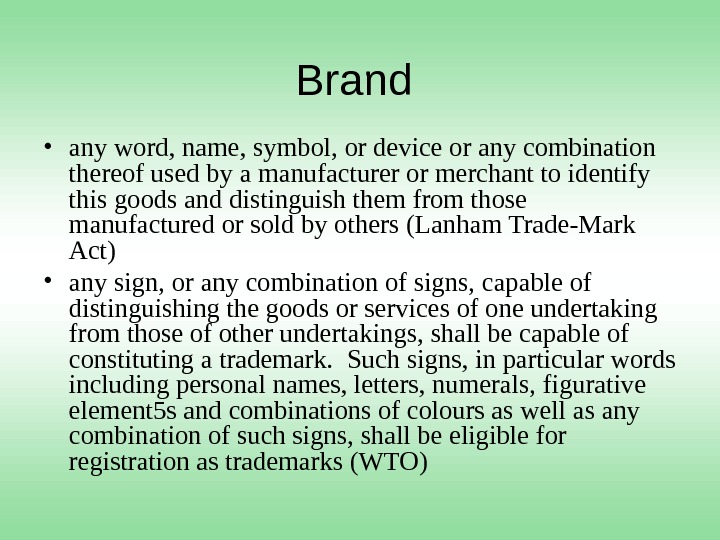
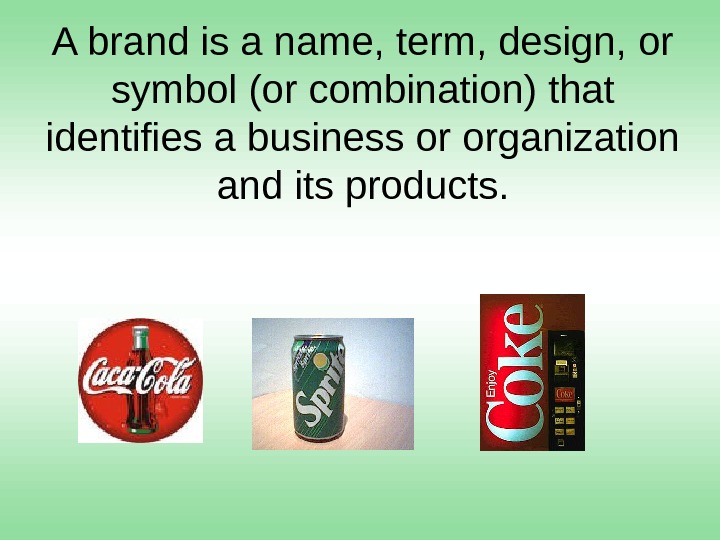

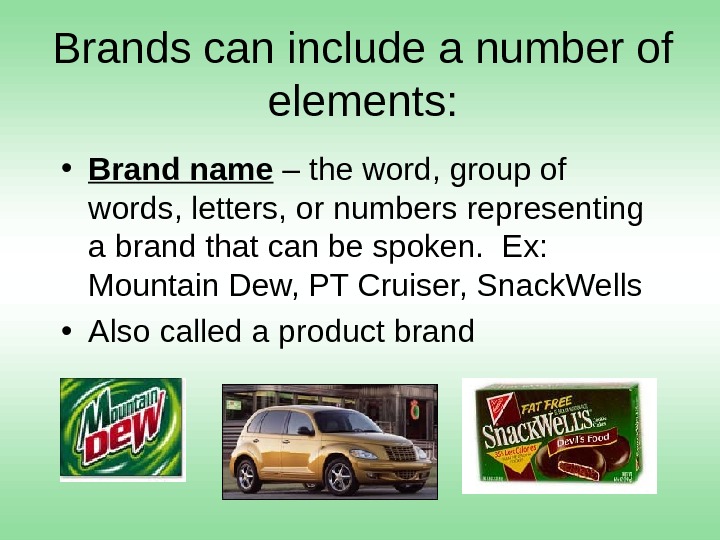
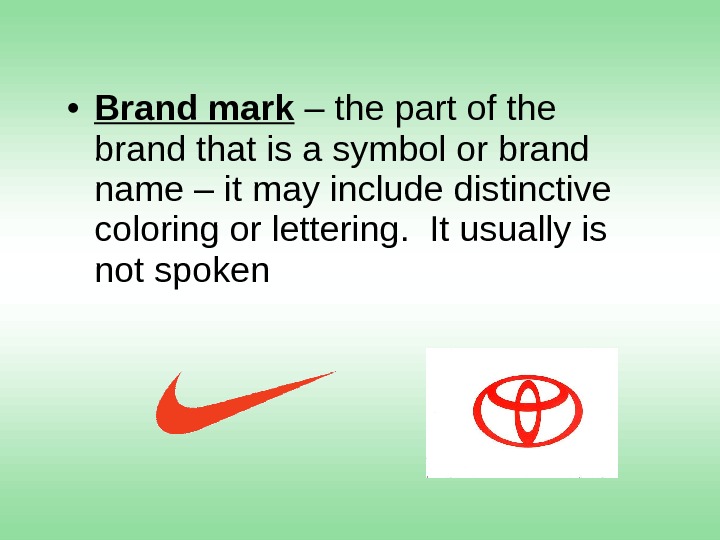
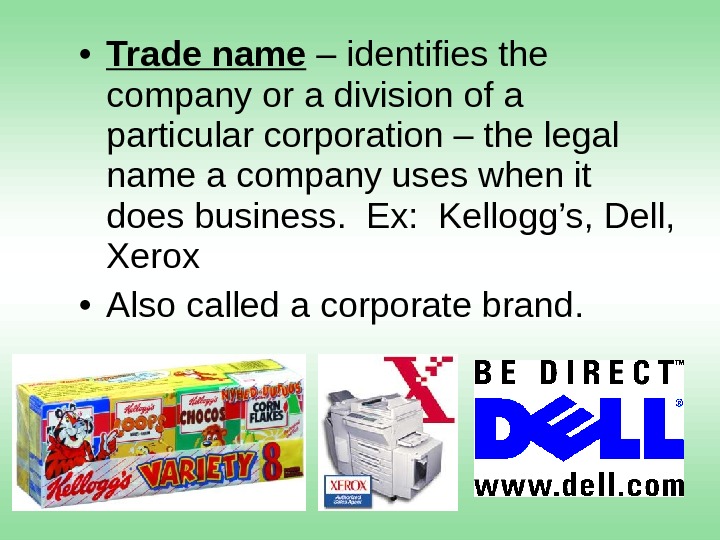

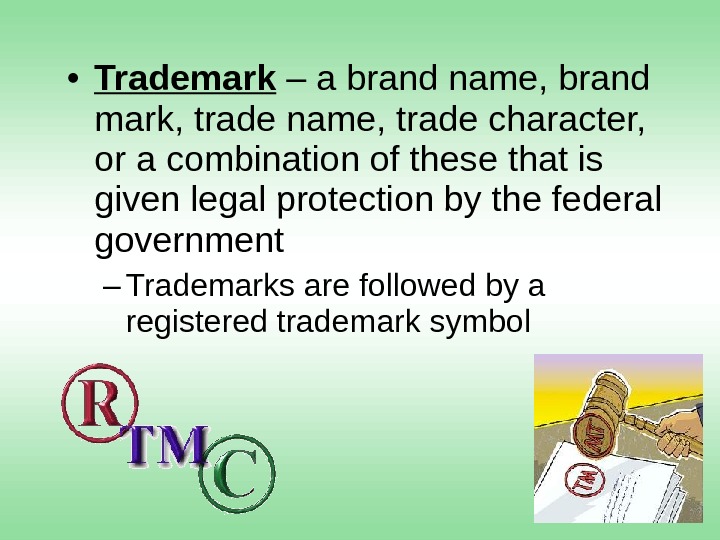
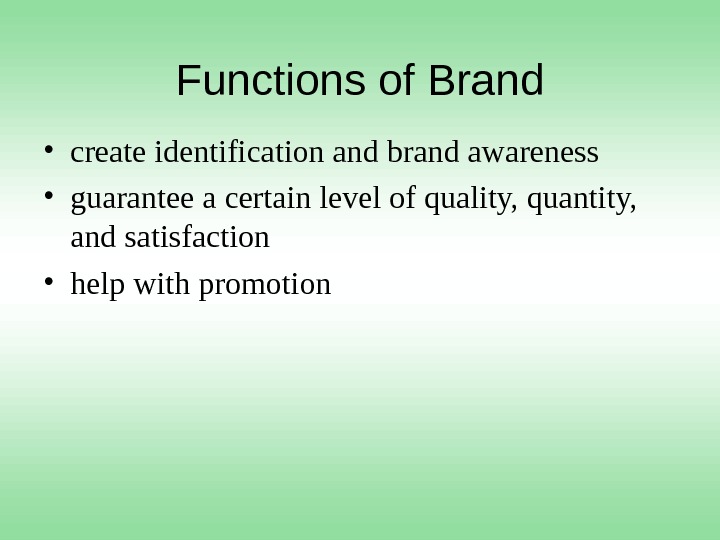
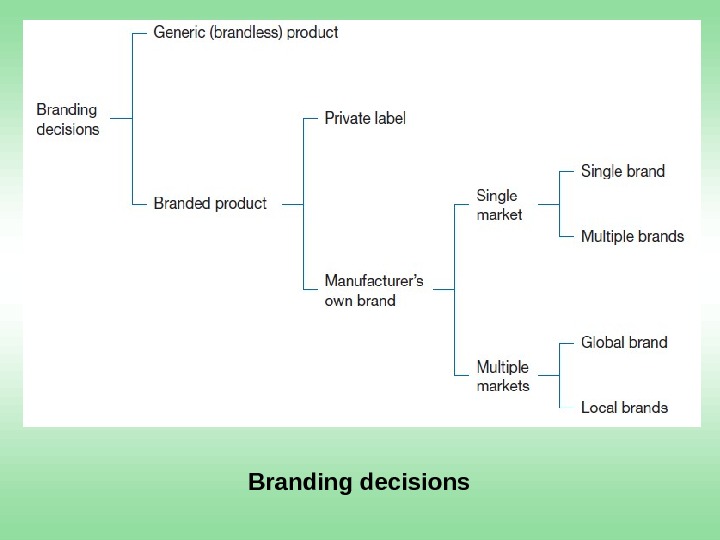

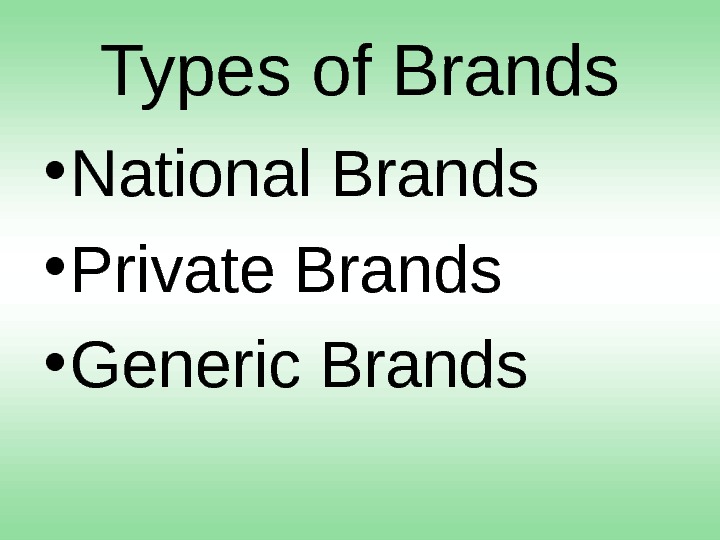

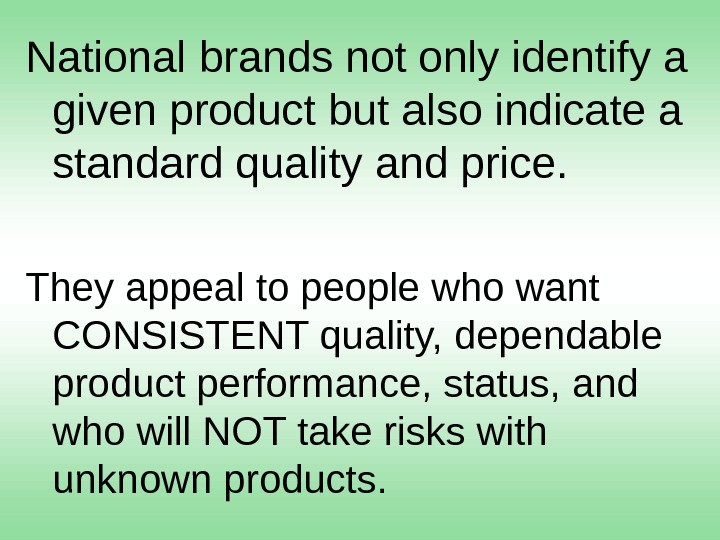
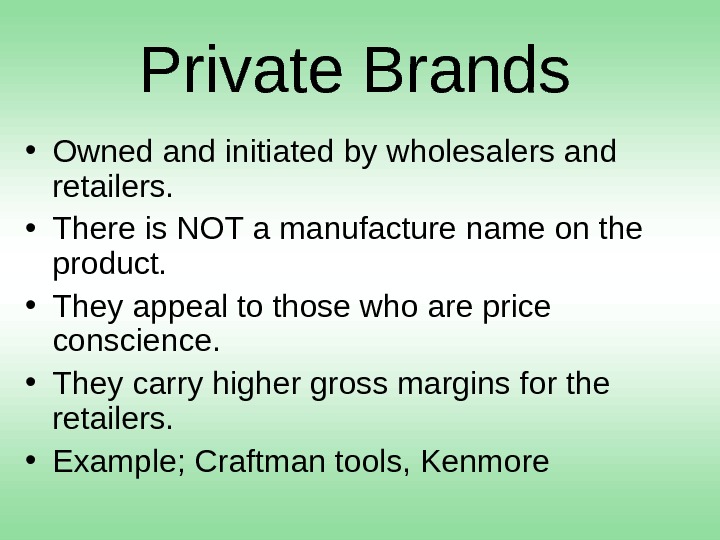
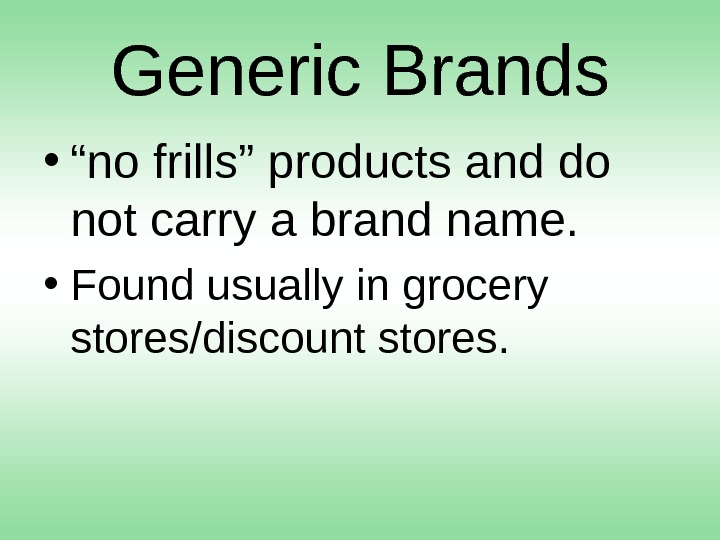
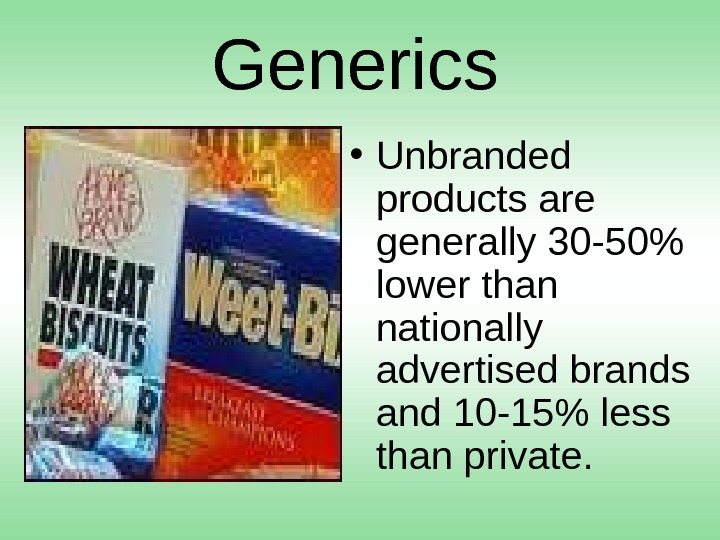
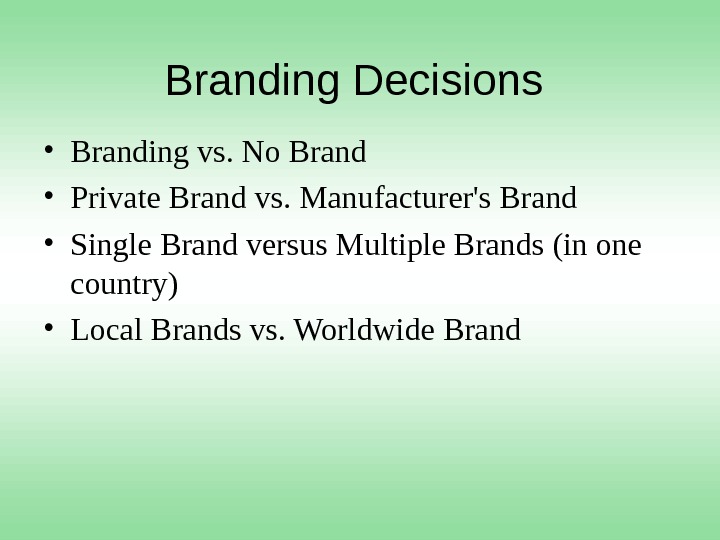
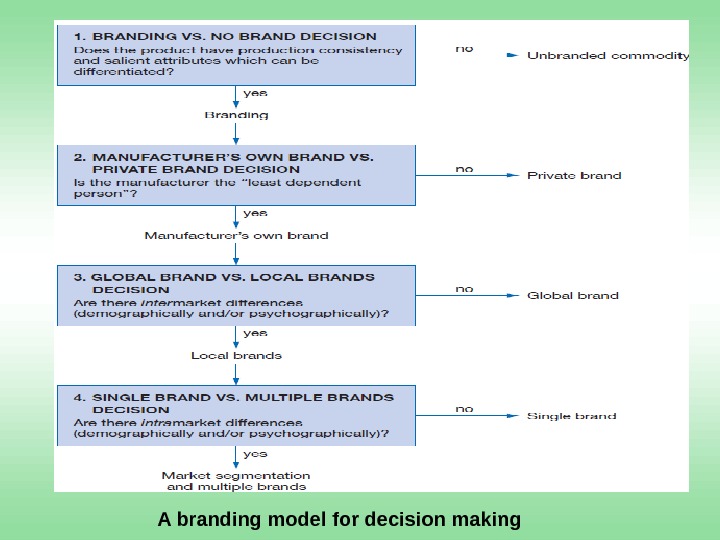
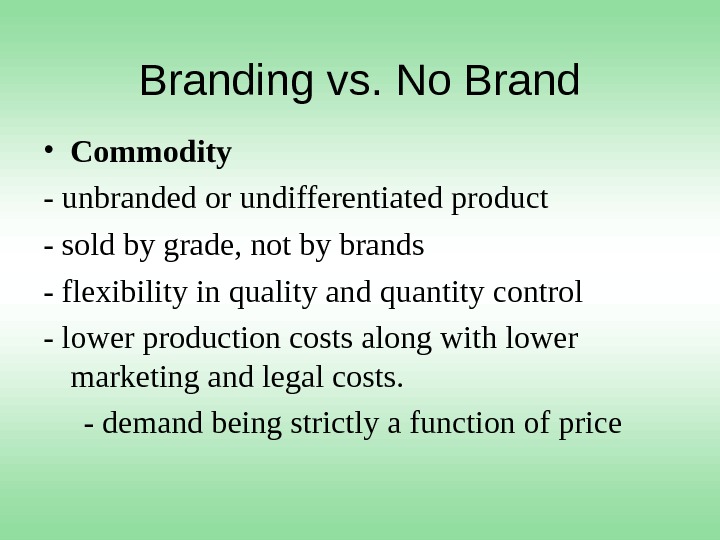
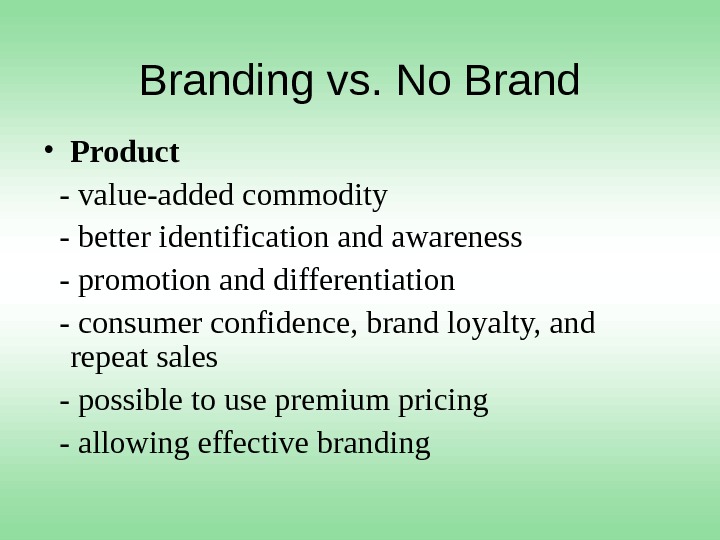


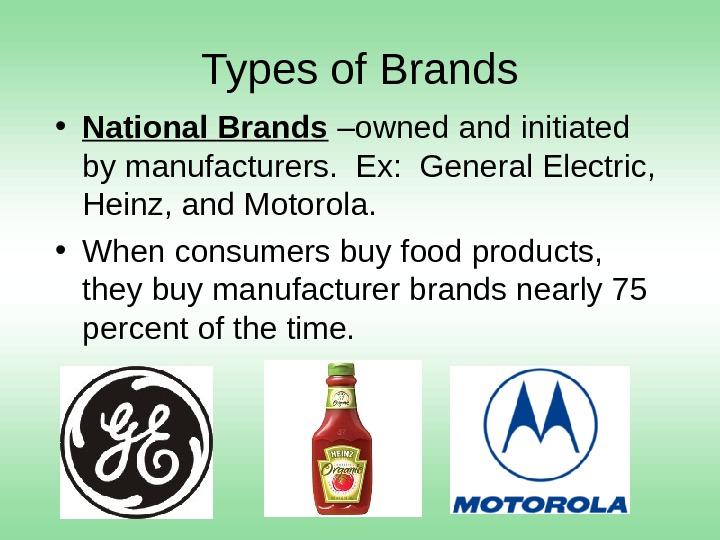

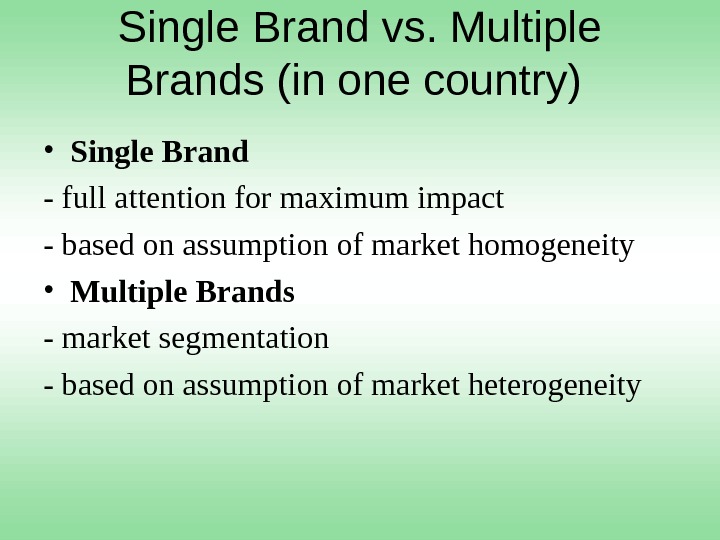
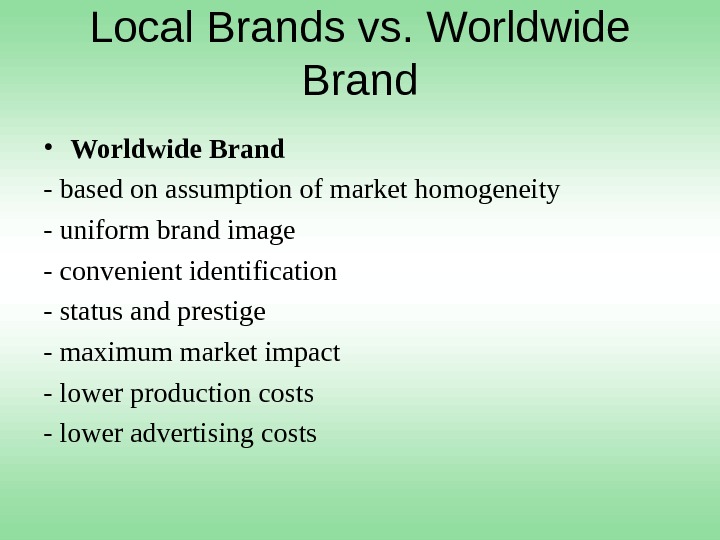
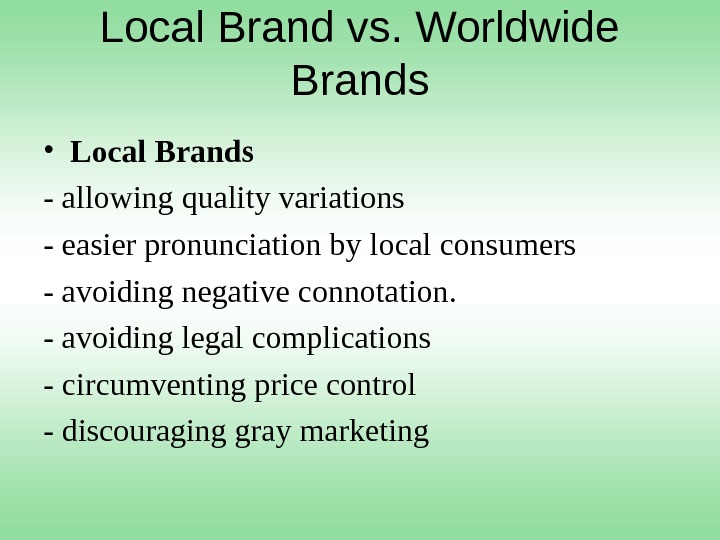
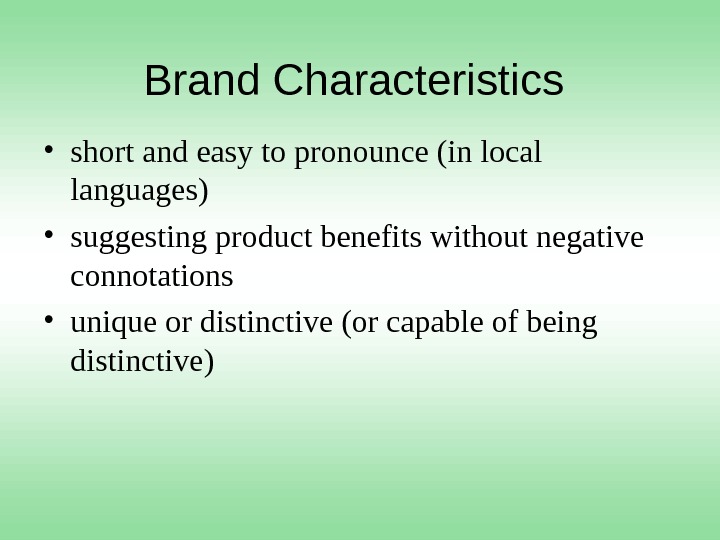

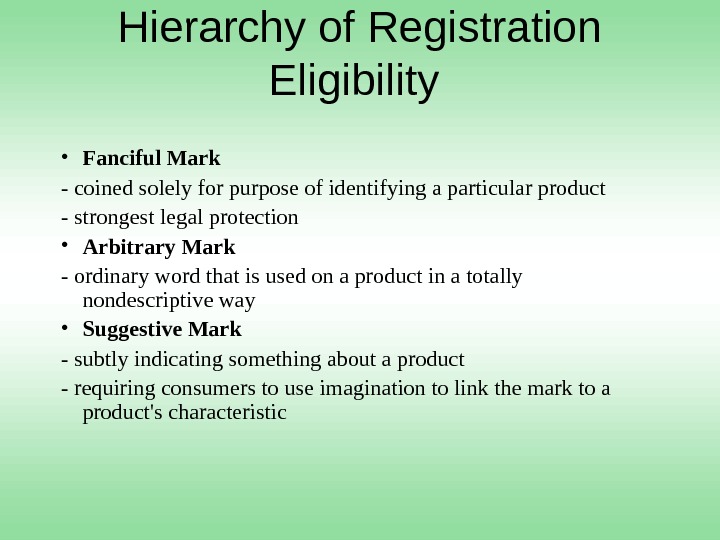

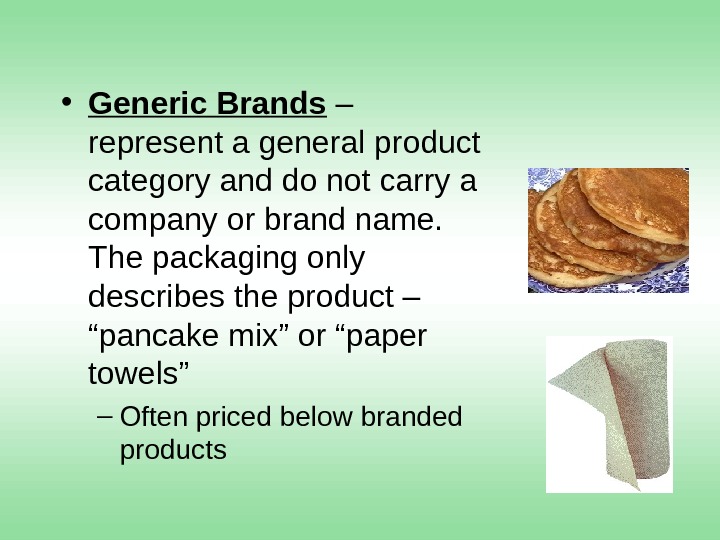

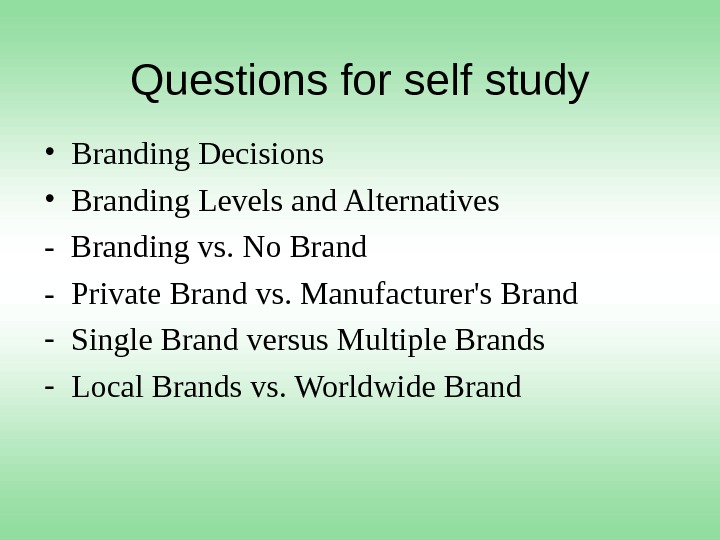

marketing_branding_27_02_13.ppt
- Размер: 722.5 Кб
- Количество слайдов: 38
Описание презентации Product Strategies: Branding & Packaging Decisions по слайдам
 Product Strategies: Branding & Packaging Decisions
Product Strategies: Branding & Packaging Decisions
 • The nature, scope, and importance of branding in product planning • The various branding elements • The different types of brands • Packaging
• The nature, scope, and importance of branding in product planning • The various branding elements • The different types of brands • Packaging
 Brand • any word, name, symbol, or device or any combination thereof used by a manufacturer or merchant to identify this goods and distinguish them from those manufactured or sold by others (Lanham Trade-Mark Act) • any sign, or any combination of signs, capable of distinguishing the goods or services of one undertaking from those of other undertakings, shall be capable of constituting a trademark. Such signs, in particular words including personal names, letters, numerals, figurative element 5 s and combinations of colours as well as any combination of such signs, shall be eligible for registration as trademarks (WTO)
Brand • any word, name, symbol, or device or any combination thereof used by a manufacturer or merchant to identify this goods and distinguish them from those manufactured or sold by others (Lanham Trade-Mark Act) • any sign, or any combination of signs, capable of distinguishing the goods or services of one undertaking from those of other undertakings, shall be capable of constituting a trademark. Such signs, in particular words including personal names, letters, numerals, figurative element 5 s and combinations of colours as well as any combination of such signs, shall be eligible for registration as trademarks (WTO)
 A brand is a name, term, design, or symbol (or combination) that identifies a business or organization and its products.
A brand is a name, term, design, or symbol (or combination) that identifies a business or organization and its products.
 Brands include: • Brand Name • Brand Mark • Trade Name • Trade Character • Trademark
Brands include: • Brand Name • Brand Mark • Trade Name • Trade Character • Trademark
 Brands can include a number of elements: • Brand name – the word, group of words, letters, or numbers representing a brand that can be spoken. Ex: Mountain Dew, PT Cruiser, Snack. Wells • Also called a product brand
Brands can include a number of elements: • Brand name – the word, group of words, letters, or numbers representing a brand that can be spoken. Ex: Mountain Dew, PT Cruiser, Snack. Wells • Also called a product brand
 • Brand mark – the part of the brand that is a symbol or brand name – it may include distinctive coloring or lettering. It usually is not spoken
• Brand mark – the part of the brand that is a symbol or brand name – it may include distinctive coloring or lettering. It usually is not spoken
 • Trade name – identifies the company or a division of a particular corporation – the legal name a company uses when it does business. Ex: Kellogg’s, Dell, Xerox • Also called a corporate brand.
• Trade name – identifies the company or a division of a particular corporation – the legal name a company uses when it does business. Ex: Kellogg’s, Dell, Xerox • Also called a corporate brand.
 • Trade character – a brand mark with human form or characteristics. Ex: Jolly Green Giant, Pillsbury Doughboy, Kellogg’s Tony the Tiger
• Trade character – a brand mark with human form or characteristics. Ex: Jolly Green Giant, Pillsbury Doughboy, Kellogg’s Tony the Tiger
 • Trademark – a brand name, brand mark, trade name, trade character, or a combination of these that is given legal protection by the federal government – Trademarks are followed by a registered trademark symbol
• Trademark – a brand name, brand mark, trade name, trade character, or a combination of these that is given legal protection by the federal government – Trademarks are followed by a registered trademark symbol
 Functions of Brand • create identification and brand awareness • guarantee a certain level of quality, quantity, and satisfaction • help with promotion
Functions of Brand • create identification and brand awareness • guarantee a certain level of quality, quantity, and satisfaction • help with promotion
 Branding decisions
Branding decisions
 Generating Brands • Hard to find the right name • Generated by employees, computer programs, PR agencies • Most companies do research to determine if the brand name is effective
Generating Brands • Hard to find the right name • Generated by employees, computer programs, PR agencies • Most companies do research to determine if the brand name is effective
 Types of Brands • National Brands • Private Brands • Generic Brands
Types of Brands • National Brands • Private Brands • Generic Brands
 National Brands • Also called “manufacturer brands. ” • Examples : Pepsi, Kellogg’s, IBM. • National brands generate the majority of sales for most product categories: 70% of all food products, 65% of all appliances, 80% of all gasoline are sold under national brands.
National Brands • Also called “manufacturer brands. ” • Examples : Pepsi, Kellogg’s, IBM. • National brands generate the majority of sales for most product categories: 70% of all food products, 65% of all appliances, 80% of all gasoline are sold under national brands.
 National brands not only identify a given product but also indicate a standard quality and price. They appeal to people who want CONSISTENT quality, dependable product performance, status, and who will NOT take risks with unknown products.
National brands not only identify a given product but also indicate a standard quality and price. They appeal to people who want CONSISTENT quality, dependable product performance, status, and who will NOT take risks with unknown products.
 Private Brands • Owned and initiated by wholesalers and retailers. • There is NOT a manufacture name on the product. • They appeal to those who are price conscience. • They carry higher gross margins for the retailers. • Example; Craftman tools, Kenmore
Private Brands • Owned and initiated by wholesalers and retailers. • There is NOT a manufacture name on the product. • They appeal to those who are price conscience. • They carry higher gross margins for the retailers. • Example; Craftman tools, Kenmore
 Generic Brands • “ no frills” products and do not carry a brand name. • Found usually in grocery stores/discount stores.
Generic Brands • “ no frills” products and do not carry a brand name. • Found usually in grocery stores/discount stores.
 Generics • Unbranded products are generally 30 -50% lower than nationally advertised brands and 10 -15% less than private.
Generics • Unbranded products are generally 30 -50% lower than nationally advertised brands and 10 -15% less than private.
 Branding Decisions • Branding vs. No Brand • Private Brand vs. Manufacturer’s Brand • Single Brand versus Multiple Brands (in one country) • Local Brands vs. Worldwide Brand
Branding Decisions • Branding vs. No Brand • Private Brand vs. Manufacturer’s Brand • Single Brand versus Multiple Brands (in one country) • Local Brands vs. Worldwide Brand
 A branding model for decision making
A branding model for decision making
 Branding vs. No Brand • Commodity — unbranded or undifferentiated product — sold by grade, not by brands — flexibility in quality and quantity control — lower production costs along with lower marketing and legal costs. — demand being strictly a function of price
Branding vs. No Brand • Commodity — unbranded or undifferentiated product — sold by grade, not by brands — flexibility in quality and quantity control — lower production costs along with lower marketing and legal costs. — demand being strictly a function of price
 Branding vs. No Brand • Product — value-added commodity — better identification and awareness — promotion and differentiation — consumer confidence, brand loyalty, and repeat sales — possible to use premium pricing — allowing effective branding
Branding vs. No Brand • Product — value-added commodity — better identification and awareness — promotion and differentiation — consumer confidence, brand loyalty, and repeat sales — possible to use premium pricing — allowing effective branding
 Private Brand vs. Manufacturer’s Brand • Distributor’s (Private) Brand – lower retail price for price-sensitive consumers – higher profit margin for distributor • Manufacturer’s Brand – better image and market acceptance – no promotion hassles for distributor
Private Brand vs. Manufacturer’s Brand • Distributor’s (Private) Brand – lower retail price for price-sensitive consumers – higher profit margin for distributor • Manufacturer’s Brand – better image and market acceptance – no promotion hassles for distributor
 Private Brand vs. Manufacturer’s Brand • «Least Dependent Person» Hypothesis — least dependent person is stronger party — stronger party has more resources and market acceptance — least dependent person is likely to prevail on brand choice
Private Brand vs. Manufacturer’s Brand • «Least Dependent Person» Hypothesis — least dependent person is stronger party — stronger party has more resources and market acceptance — least dependent person is likely to prevail on brand choice
 Types of Brands • National Brands –owned and initiated by manufacturers. Ex: General Electric, Heinz, and Motorola. • When consumers buy food products, they buy manufacturer brands nearly 75 percent of the time.
Types of Brands • National Brands –owned and initiated by manufacturers. Ex: General Electric, Heinz, and Motorola. • When consumers buy food products, they buy manufacturer brands nearly 75 percent of the time.
 • Private Distributor Brands – also called Private Brands, Store Brands, or Dealer Brands – owned and initiated by wholesalers and retailers. Ex: Radio Shack and Kmart, Craftsman, Kirkland • This type of brand can be controlled by retailers and it yields the highest profits.
• Private Distributor Brands – also called Private Brands, Store Brands, or Dealer Brands – owned and initiated by wholesalers and retailers. Ex: Radio Shack and Kmart, Craftsman, Kirkland • This type of brand can be controlled by retailers and it yields the highest profits.
 Single Brand vs. Multiple Brands (in one country) • Single Brand — full attention for maximum impact — based on assumption of market homogeneity • Multiple Brands — market segmentation — based on assumption of market heterogeneity
Single Brand vs. Multiple Brands (in one country) • Single Brand — full attention for maximum impact — based on assumption of market homogeneity • Multiple Brands — market segmentation — based on assumption of market heterogeneity
 Local Brands vs. Worldwide Brand • Worldwide Brand — based on assumption of market homogeneity — uniform brand image — convenient identification — status and prestige — maximum market impact — lower production costs — lower advertising costs
Local Brands vs. Worldwide Brand • Worldwide Brand — based on assumption of market homogeneity — uniform brand image — convenient identification — status and prestige — maximum market impact — lower production costs — lower advertising costs
 Local Brand vs. Worldwide Brands • Local Brands — allowing quality variations — easier pronunciation by local consumers — avoiding negative connotation. — avoiding legal complications — circumventing price control — discouraging gray marketing
Local Brand vs. Worldwide Brands • Local Brands — allowing quality variations — easier pronunciation by local consumers — avoiding negative connotation. — avoiding legal complications — circumventing price control — discouraging gray marketing
 Brand Characteristics • short and easy to pronounce (in local languages) • suggesting product benefits without negative connotations • unique or distinctive (or capable of being distinctive)
Brand Characteristics • short and easy to pronounce (in local languages) • suggesting product benefits without negative connotations • unique or distinctive (or capable of being distinctive)
 Hierarchy of Registration Eligibility • Fanciful Mark • Arbitrary Mark • Suggestive Mark • Descriptive Mark • Generic Mark
Hierarchy of Registration Eligibility • Fanciful Mark • Arbitrary Mark • Suggestive Mark • Descriptive Mark • Generic Mark
 Hierarchy of Registration Eligibility • Fanciful Mark — coined solely for purpose of identifying a particular product — strongest legal protection • Arbitrary Mark — ordinary word that is used on a product in a totally nondescriptive way • Suggestive Mark — subtly indicating something about a product — requiring consumers to use imagination to link the mark to a product’s characteristic
Hierarchy of Registration Eligibility • Fanciful Mark — coined solely for purpose of identifying a particular product — strongest legal protection • Arbitrary Mark — ordinary word that is used on a product in a totally nondescriptive way • Suggestive Mark — subtly indicating something about a product — requiring consumers to use imagination to link the mark to a product’s characteristic
 Hierarchy of Registration Eligibility • Descriptive Mark — immediately conveying a product’s characteristic, quality, or feature — not requiring consumers to use imagination • Generic Mark — identifying a product rather than its manufacturer/marketer — no legal protection
Hierarchy of Registration Eligibility • Descriptive Mark — immediately conveying a product’s characteristic, quality, or feature — not requiring consumers to use imagination • Generic Mark — identifying a product rather than its manufacturer/marketer — no legal protection
 • Generic Brands – represent a general product category and do not carry a company or brand name. The packaging only describes the product – “pancake mix” or “paper towels” – Often priced below branded products
• Generic Brands – represent a general product category and do not carry a company or brand name. The packaging only describes the product – “pancake mix” or “paper towels” – Often priced below branded products
 Packaging • Functions – Functional: protection – Promotional • Modification – Mandatory – Optional
Packaging • Functions – Functional: protection – Promotional • Modification – Mandatory – Optional
 Questions for self study • Branding Decisions • Branding Levels and Alternatives — Branding vs. No Brand — Private Brand vs. Manufacturer’s Brand — Single Brand versus Multiple Brands — Local Brands vs. Worldwide Brand
Questions for self study • Branding Decisions • Branding Levels and Alternatives — Branding vs. No Brand — Private Brand vs. Manufacturer’s Brand — Single Brand versus Multiple Brands — Local Brands vs. Worldwide Brand
 Questions for self study • Brand Consolidation • Brand Origin and Selection • Brand Characteristics • Brand Protection • Packaging: Functions and Criteria • Mandatory Package Modification • Optional Package Modification
Questions for self study • Brand Consolidation • Brand Origin and Selection • Brand Characteristics • Brand Protection • Packaging: Functions and Criteria • Mandatory Package Modification • Optional Package Modification

